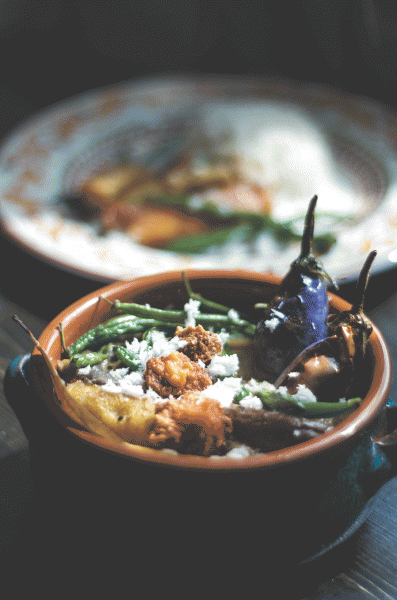Sarat, a fleeting season between Monsoon and Autumn, is the most favorite season of Bengalis (India has 6 distinct seasons), not only because it is marked by the three most important religious festivals of the Bengali calendar, but because the primary icons of these festivals are three Goddesses, namely Durga, Kali, and Lakshmi. The sun starts to mellow in Sarat and the air is crisp and fragrant with shiulis. It’s as if the Goddesses usher love, hope, and ebullience. The ebullience of nature and the liberating effect of the festive season is accompanied by another dominant Bengali pleasure—food! The presence of the Goddesses elevates food to a divine level. Somehow, however illusory it may sound, pujo food or bhog (food offered to Gods and Goddesses) tastes significantly better when ritually offered to and accepted by the Goddesses. Perhaps it’s the dhuno and incense smoke, or the belpata, or the marigold, tuberose and hibiscus petals adorning pujo baris (family houses where the festivals are ritually celebrated) that lend their smells to the bhog or delectable pujo-bari meals.
Shukto is one such Bengali delicacy that, I think, is transformed in their pujo-bari renditions. In fact, the recipe is such that they are best suited for communal meals. Since shukto uses several kinds of vegetables, it’s impossible to make shukto just for two people. And because sharing, giving, and receiving are such a crucial part of Bengali cultural celebrations–which are always chaotic, exuberant, cacophonic, and public–it is no surprise that a festive Bengali lunch menu traditionally starts with shukto and rice.

What’s even more interesting is that shukto has been around for at least two centuries. The recipe can be attributed to the Portuguese who brought potatoes and sweet potatoes to Bengal in 1780. A favorite Bengali palate cleanser, made with lots of different vegetables, simmered in broth with a hint of sugar and milk to bring out the bitterness of the fresh vegetables, shukto is a delicacy that has evolved over time. Bearing witness to the cultural crossovers that lend Indian cuisine its multifariousness, shukto is one such dish that withstands the colonial stereotype that terms all Indian dishes “curries”.
This recipe requires some special knife-skills. Unless you use bonti, you will find this video instructive.


Traditional Dush Shukto recipe
Ingredients
- mustard/canola oil for deep frying
- 1 potato cut into 1/2 inch batonnet
- 1 sweet potato cut into 1/2 inch batonnet
- 1 plantain cut into 1/2 inch batonnet
- 1/2 of a large eggplant cut into 1/2 inch batonnet
- 10-12 2 inch pieces of drumsticks
- 2 bitter gourds sliced
- 10-12 boris
For the gravy
- 2 tbsp mustard oil
- 1 tsp paanch phoron
- 2 bay leaves
- 1 tbsp ginger paste
- 2 cups water
- 1 tbsp radhuni paste
- 2 tbsp mustard paste
- 2 tbsp posto/poppy seeds paste
- salt to taste
- 1 tbsp sugar
- 1/2 cup milk
- 1 tbsp ghee
- 1/2 cup grated coconut
Instructions
- First, deep fry all the vegetables and boris. Because each vegetable has a different cooking time, you must remember to fry them separately (this step can be done ahead).
- In a fresh pan heat 2 tbsp mustard oil. Add paanch phoron, bay leaves, and ginger paste and simmer for a minute. Add water and bring it to a boil.
- Add all the fried veggies and bori to the pan.
- Then add radhuni paste, mustard paste, poppy seed paste, salt and sugar. Let it cook for 2-3 more minutes.
- Now reduce heat and add milk. Cover and let it simmer for 5 minutes.
- Remove from heat, add ghee and garnish with grated coconut. Serve at room temperature with steamed white rice.
Notes
Instead of large eggplant I used 6-8 small eggplants because they look pretty.
Nutrition


Leave a Reply